engine coolant FORD F-350 2022 Owners Manual
[x] Cancel search | Manufacturer: FORD, Model Year: 2022, Model line: F-350, Model: FORD F-350 2022Pages: 740, PDF Size: 12.6 MB
Page 7 of 740
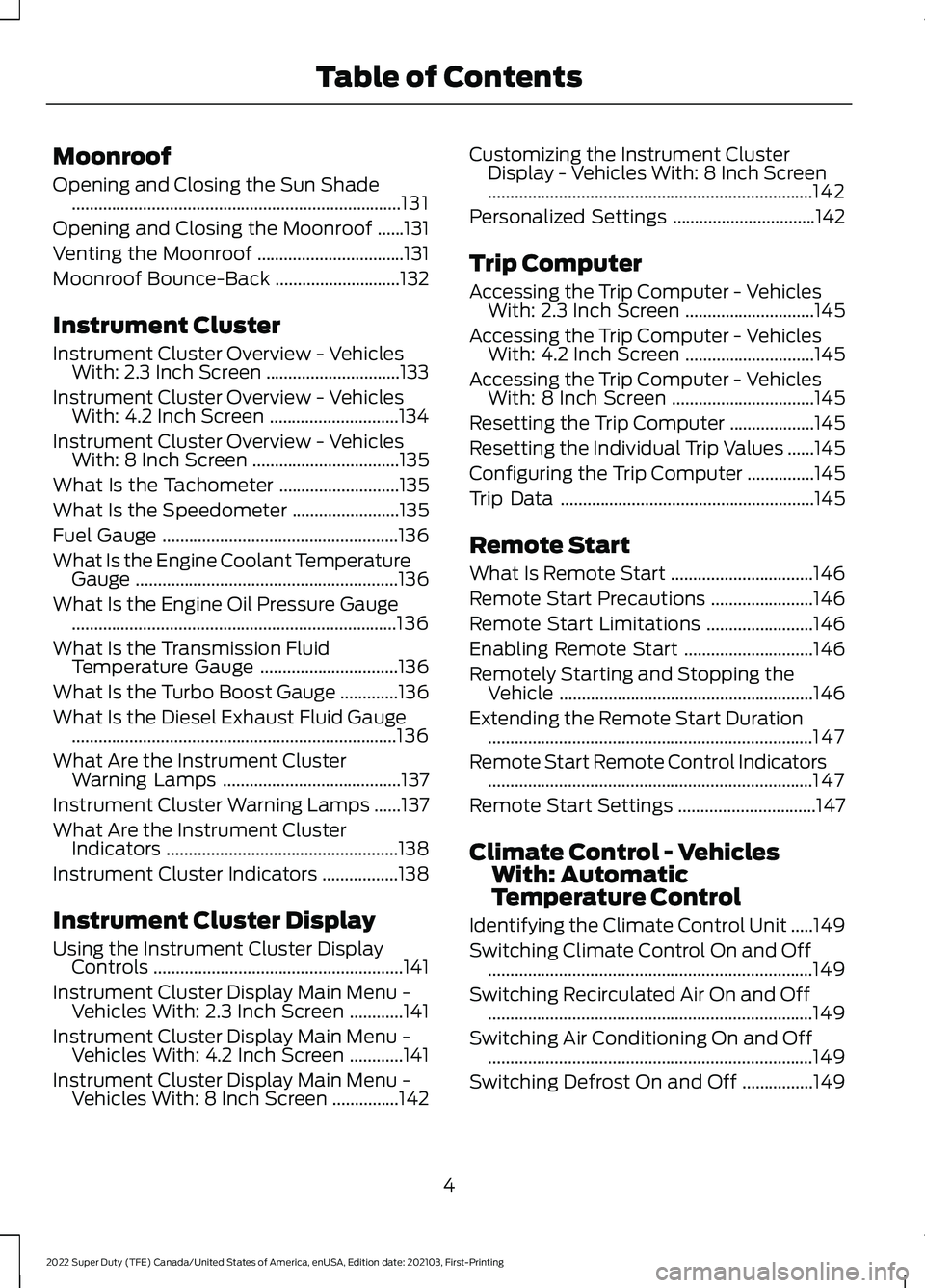
Moonroof
Opening and Closing the Sun Shade
........................................................................\
..131
Opening and Closing the Moonroof ......
131
Venting the Moonroof .................................
131
Moonroof Bounce-Back ............................
132
Instrument Cluster
Instrument Cluster Overview - Vehicles With: 2.3 Inch Screen ..............................
133
Instrument Cluster Overview - Vehicles With: 4.2 Inch Screen .............................
134
Instrument Cluster Overview - Vehicles With: 8 Inch Screen .................................
135
What Is the Tachometer ...........................
135
What Is the Speedometer ........................
135
Fuel Gauge .....................................................
136
What Is the Engine Coolant Temperature Gauge ...........................................................
136
What Is the Engine Oil Pressure Gauge ........................................................................\
.
136
What Is the Transmission Fluid Temperature Gauge ...............................
136
What Is the Turbo Boost Gauge .............
136
What Is the Diesel Exhaust Fluid Gauge ........................................................................\
.
136
What Are the Instrument Cluster Warning Lamps ........................................
137
Instrument Cluster Warning Lamps ......
137
What Are the Instrument Cluster Indicators ....................................................
138
Instrument Cluster Indicators .................
138
Instrument Cluster Display
Using the Instrument Cluster Display Controls ........................................................
141
Instrument Cluster Display Main Menu - Vehicles With: 2.3 Inch Screen ............
141
Instrument Cluster Display Main Menu - Vehicles With: 4.2 Inch Screen ............
141
Instrument Cluster Display Main Menu - Vehicles With: 8 Inch Screen ...............
142Customizing the Instrument Cluster
Display - Vehicles With: 8 Inch Screen
........................................................................\
.
142
Personalized Settings ................................
142
Trip Computer
Accessing the Trip Computer - Vehicles With: 2.3 Inch Screen .............................
145
Accessing the Trip Computer - Vehicles With: 4.2 Inch Screen .............................
145
Accessing the Trip Computer - Vehicles With: 8 Inch Screen ................................
145
Resetting the Trip Computer ...................
145
Resetting the Individual Trip Values ......
145
Configuring the Trip Computer ...............
145
Trip Data .........................................................
145
Remote Start
What Is Remote Start ................................
146
Remote Start Precautions .......................
146
Remote Start Limitations ........................
146
Enabling Remote Start .............................
146
Remotely Starting and Stopping the Vehicle .........................................................
146
Extending the Remote Start Duration ........................................................................\
.
147
Remote Start Remote Control Indicators ........................................................................\
.
147
Remote Start Settings ...............................
147
Climate Control - Vehicles With: Automatic
Temperature Control
Identifying the Climate Control Unit .....
149
Switching Climate Control On and Off ........................................................................\
.
149
Switching Recirculated Air On and Off ........................................................................\
.
149
Switching Air Conditioning On and Off ........................................................................\
.
149
Switching Defrost On and Off ................
149
4
2022 Super Duty (TFE) Canada/United States of America, enUSA, Edition date: 202103, First-Printing Table of Contents
Page 15 of 740
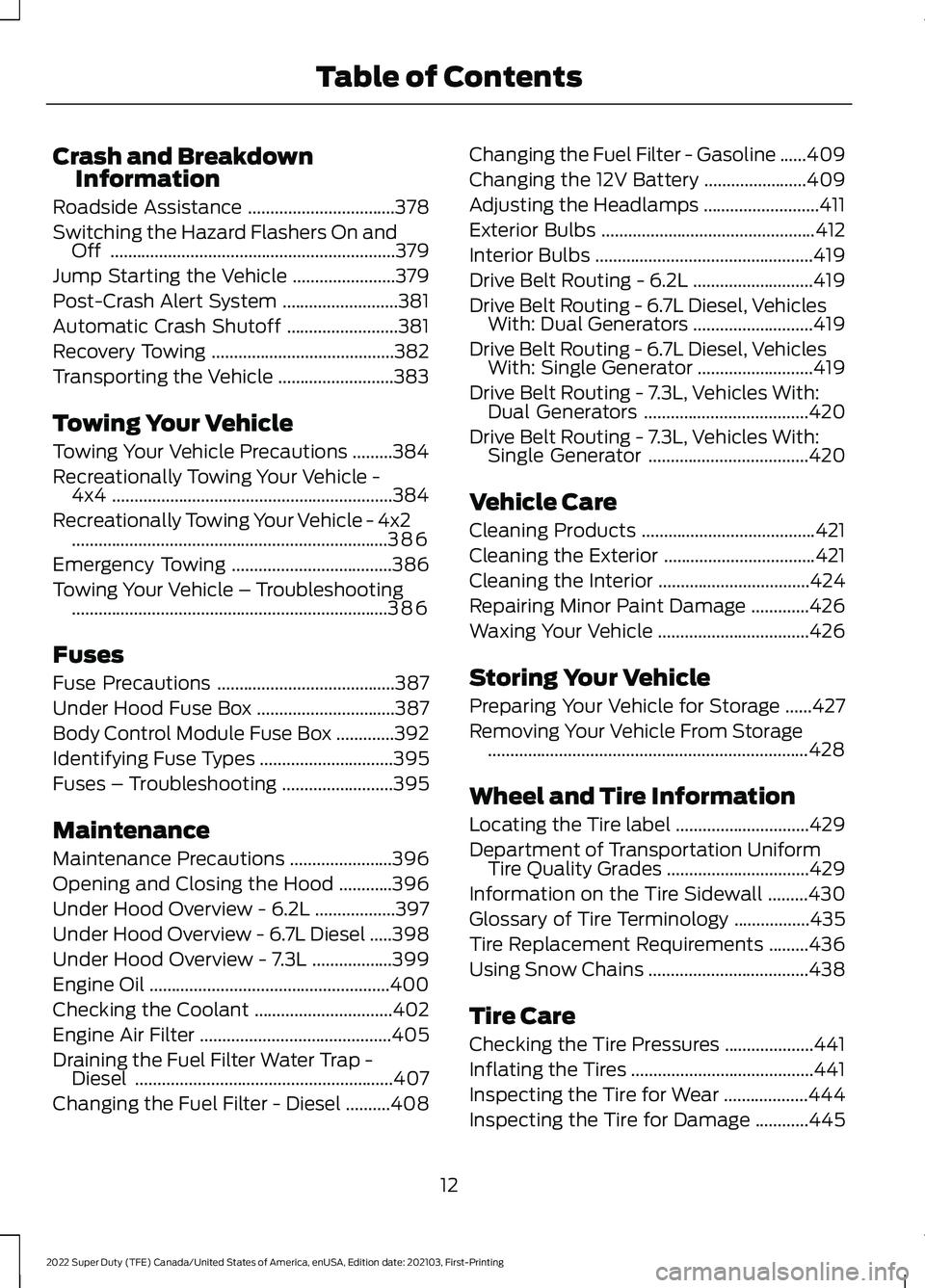
Crash and Breakdown
Information
Roadside Assistance .................................378
Switching the Hazard Flashers On and Off ................................................................
379
Jump Starting the Vehicle .......................
379
Post-Crash Alert System ..........................
381
Automatic Crash Shutoff .........................
381
Recovery Towing .........................................
382
Transporting the Vehicle ..........................
383
Towing Your Vehicle
Towing Your Vehicle Precautions .........
384
Recreationally Towing Your Vehicle - 4x4 ...............................................................
384
Recreationally Towing Your Vehicle - 4x2 .......................................................................
386
Emergency Towing ....................................
386
Towing Your Vehicle – Troubleshooting .......................................................................
386
Fuses
Fuse Precautions ........................................
387
Under Hood Fuse Box ...............................
387
Body Control Module Fuse Box .............
392
Identifying Fuse Types ..............................
395
Fuses – Troubleshooting .........................
395
Maintenance
Maintenance Precautions .......................
396
Opening and Closing the Hood ............
396
Under Hood Overview - 6.2L ..................
397
Under Hood Overview - 6.7L Diesel .....
398
Under Hood Overview - 7.3L ..................
399
Engine Oil ......................................................
400
Checking the Coolant ...............................
402
Engine Air Filter ...........................................
405
Draining the Fuel Filter Water Trap - Diesel ..........................................................
407
Changing the Fuel Filter - Diesel ..........
408Changing the Fuel Filter - Gasoline
......
409
Changing the 12V Battery .......................
409
Adjusting the Headlamps ..........................
411
Exterior Bulbs ................................................
412
Interior Bulbs .................................................
419
Drive Belt Routing - 6.2L ...........................
419
Drive Belt Routing - 6.7L Diesel, Vehicles With: Dual Generators ...........................
419
Drive Belt Routing - 6.7L Diesel, Vehicles With: Single Generator ..........................
419
Drive Belt Routing - 7.3L, Vehicles With: Dual Generators .....................................
420
Drive Belt Routing - 7.3L, Vehicles With: Single Generator ....................................
420
Vehicle Care
Cleaning Products .......................................
421
Cleaning the Exterior ..................................
421
Cleaning the Interior ..................................
424
Repairing Minor Paint Damage .............
426
Waxing Your Vehicle ..................................
426
Storing Your Vehicle
Preparing Your Vehicle for Storage ......
427
Removing Your Vehicle From Storage ........................................................................\
428
Wheel and Tire Information
Locating the Tire label ..............................
429
Department of Transportation Uniform Tire Quality Grades ................................
429
Information on the Tire Sidewall .........
430
Glossary of Tire Terminology .................
435
Tire Replacement Requirements .........
436
Using Snow Chains ....................................
438
Tire Care
Checking the Tire Pressures ....................
441
Inflating the Tires .........................................
441
Inspecting the Tire for Wear ...................
444
Inspecting the Tire for Damage ............
445
12
2022 Super Duty (TFE) Canada/United States of America, enUSA, Edition date: 202103, First-Printing Table of Contents
Page 24 of 740
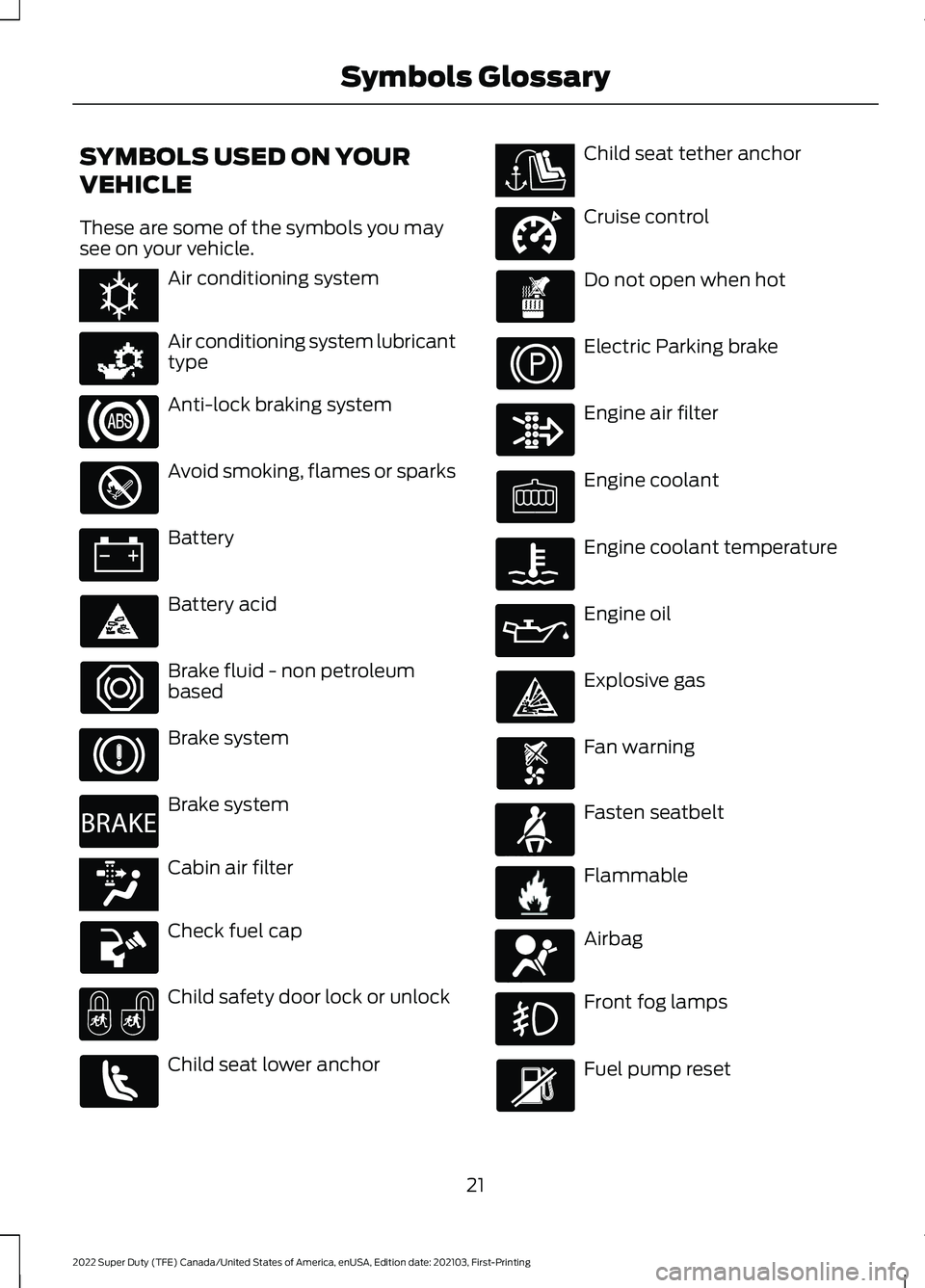
SYMBOLS USED ON YOUR
VEHICLE
These are some of the symbols you may
see on your vehicle.
Air conditioning system
Air conditioning system lubricant
type
Anti-lock braking system
Avoid smoking, flames or sparks
Battery
Battery acid
Brake fluid - non petroleum
based
Brake system
Brake system
Cabin air filter
Check fuel cap
Child safety door lock or unlock
Child seat lower anchor Child seat tether anchor
Cruise control
Do not open when hot
Electric Parking brake
Engine air filter
Engine coolant
Engine coolant temperature
Engine oil
Explosive gas
Fan warning
Fasten seatbelt
Flammable
Airbag
Front fog lamps
Fuel pump reset
21
2022 Super Duty (TFE) Canada/United States of America, enUSA, Edition date: 202103, First-Printing Symbols GlossaryE162384 E231157 E270480 E139223 E141128 E332905 E71880 E231160 E67017
Page 136 of 740
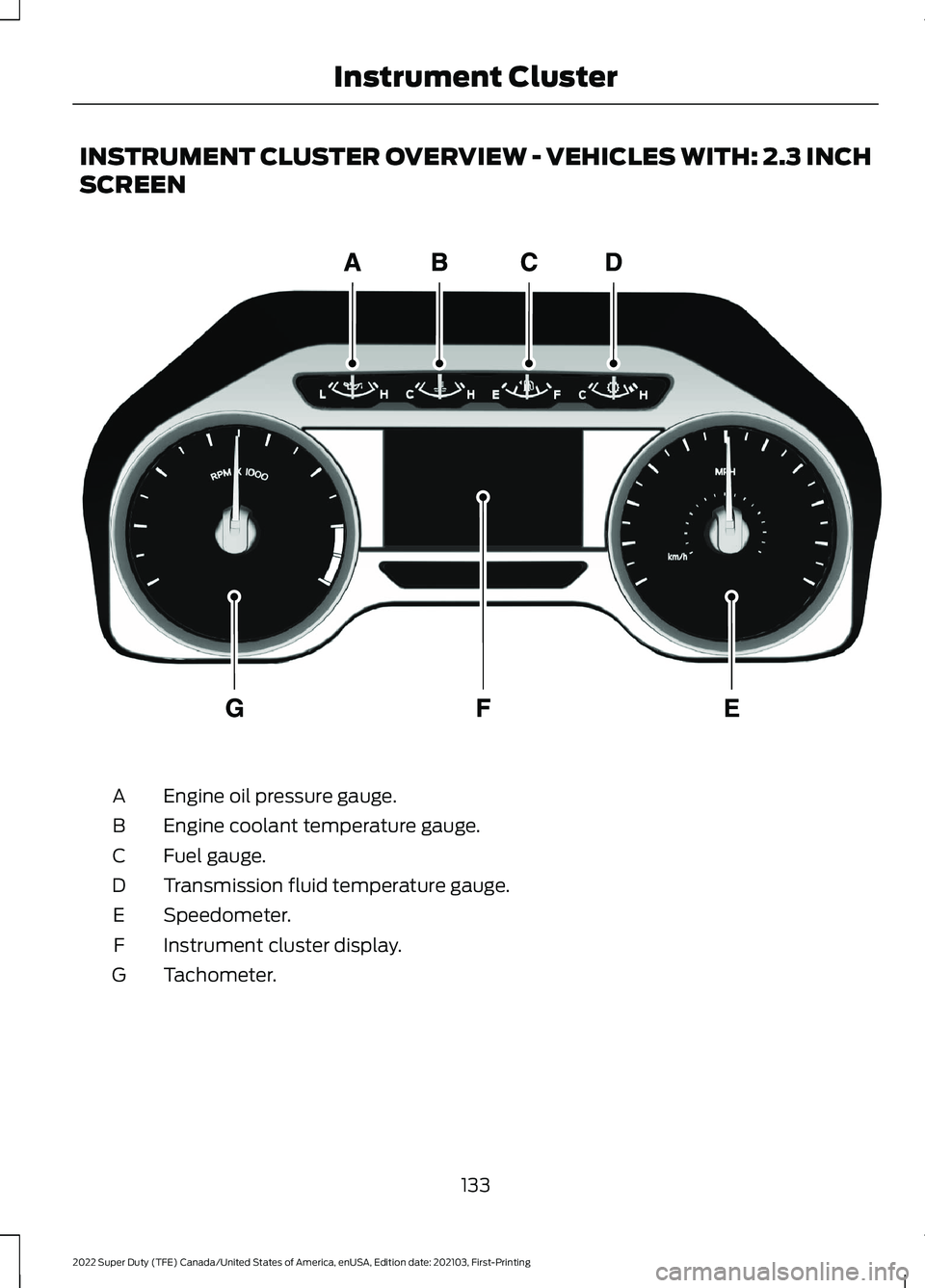
INSTRUMENT CLUSTER OVERVIEW - VEHICLES WITH: 2.3 INCH
SCREEN
Engine oil pressure gauge.
A
Engine coolant temperature gauge.
B
Fuel gauge.
C
Transmission fluid temperature gauge.
D
Speedometer.
E
Instrument cluster display.
F
Tachometer.
G
133
2022 Super Duty (TFE) Canada/United States of America, enUSA, Edition date: 202103, First-Printing Instrument ClusterE219638
Page 137 of 740

INSTRUMENT CLUSTER OVERVIEW - VEHICLES WITH: 4.2 INCH
SCREEN
Engine oil pressure gauge.
A
Engine coolant temperature gauge.
B
Fuel gauge.
C
Transmission fluid temperature gauge.
D
Speedometer.
E
Instrument cluster display.
F
Tachometer.
G
134
2022 Super Duty (TFE) Canada/United States of America, enUSA, Edition date: 202103, First-Printing Instrument ClusterE219638
Page 138 of 740
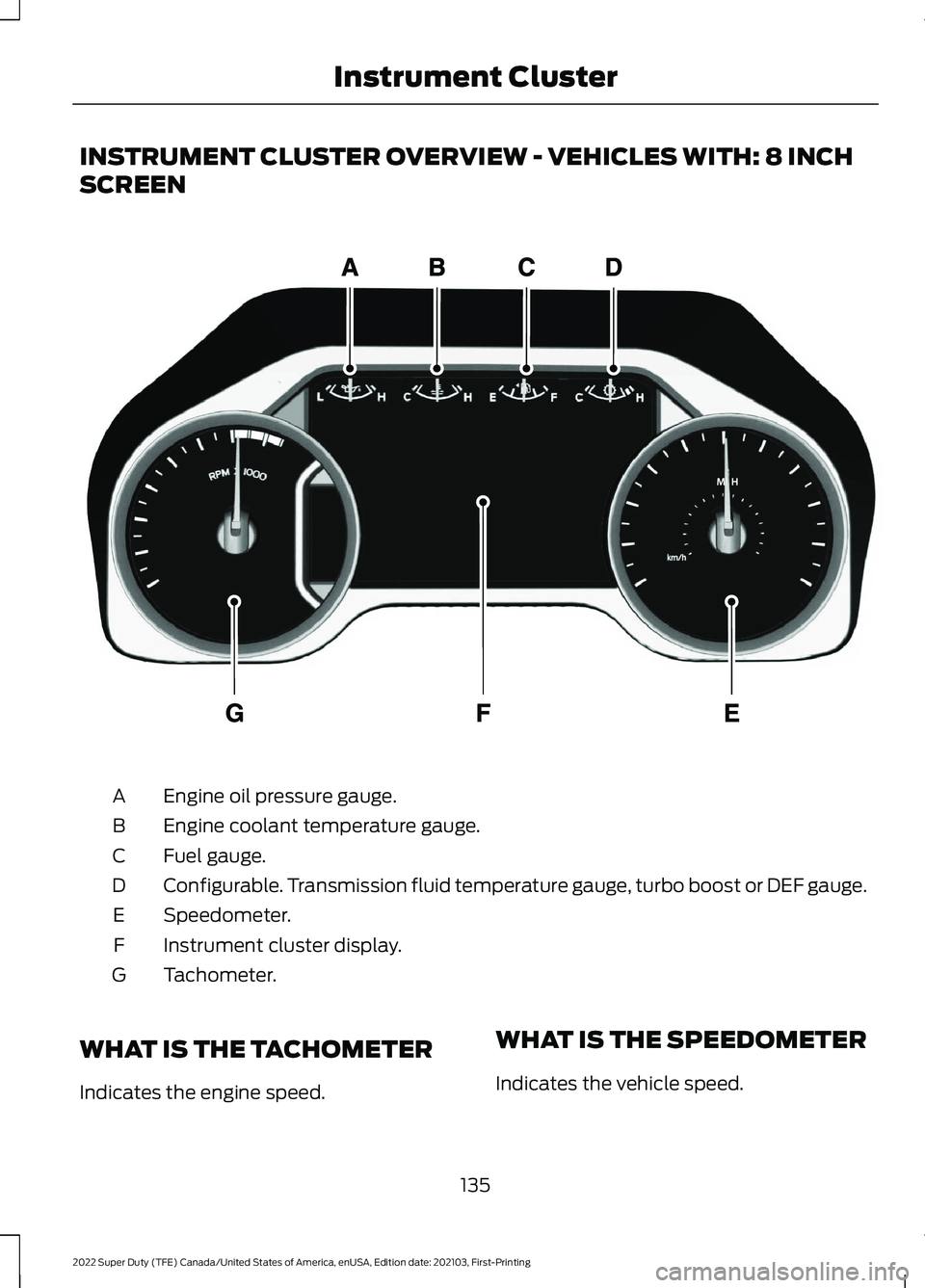
INSTRUMENT CLUSTER OVERVIEW - VEHICLES WITH: 8 INCH
SCREEN
Engine oil pressure gauge.
A
Engine coolant temperature gauge.
B
Fuel gauge.
C
Configurable. Transmission fluid temperature gauge, turbo boost or DEF gauge.
D
Speedometer.
E
Instrument cluster display.
F
Tachometer.
G
WHAT IS THE TACHOMETER
Indicates the engine speed. WHAT IS THE SPEEDOMETER
Indicates the vehicle speed.
135
2022 Super Duty (TFE) Canada/United States of America, enUSA, Edition date: 202103, First-Printing Instrument ClusterE219651
Page 139 of 740
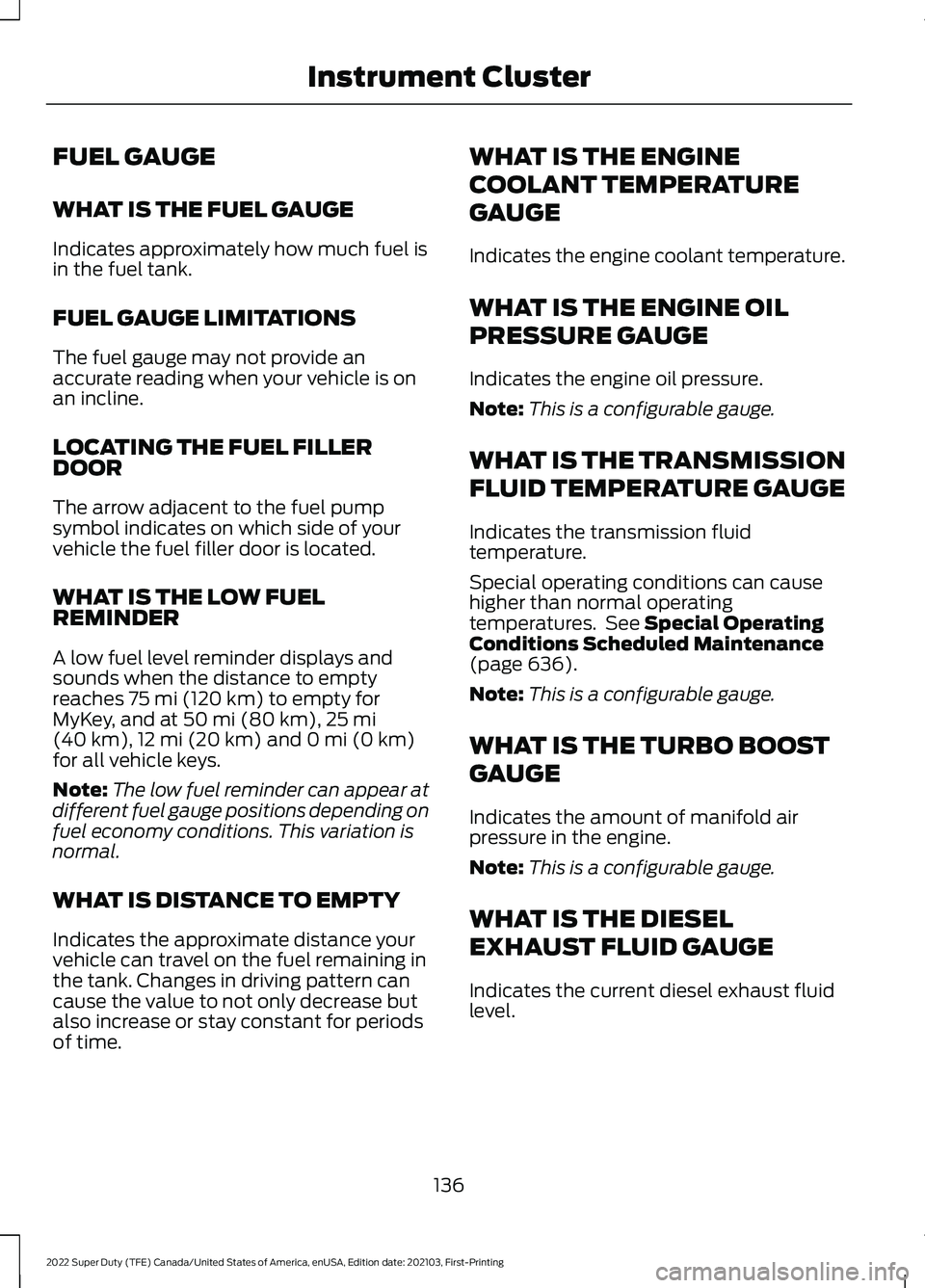
FUEL GAUGE
WHAT IS THE FUEL GAUGE
Indicates approximately how much fuel is
in the fuel tank.
FUEL GAUGE LIMITATIONS
The fuel gauge may not provide an
accurate reading when your vehicle is on
an incline.
LOCATING THE FUEL FILLER
DOOR
The arrow adjacent to the fuel pump
symbol indicates on which side of your
vehicle the fuel filler door is located.
WHAT IS THE LOW FUEL
REMINDER
A low fuel level reminder displays and
sounds when the distance to empty
reaches 75 mi (120 km) to empty for
MyKey, and at 50 mi (80 km), 25 mi
(40 km), 12 mi (20 km) and 0 mi (0 km)
for all vehicle keys.
Note: The low fuel reminder can appear at
different fuel gauge positions depending on
fuel economy conditions. This variation is
normal.
WHAT IS DISTANCE TO EMPTY
Indicates the approximate distance your
vehicle can travel on the fuel remaining in
the tank. Changes in driving pattern can
cause the value to not only decrease but
also increase or stay constant for periods
of time. WHAT IS THE ENGINE
COOLANT TEMPERATURE
GAUGE
Indicates the engine coolant temperature.
WHAT IS THE ENGINE OIL
PRESSURE GAUGE
Indicates the engine oil pressure.
Note:
This is a configurable gauge.
WHAT IS THE TRANSMISSION
FLUID TEMPERATURE GAUGE
Indicates the transmission fluid
temperature.
Special operating conditions can cause
higher than normal operating
temperatures. See
Special Operating
Conditions Scheduled Maintenance
(page
636).
Note: This is a configurable gauge.
WHAT IS THE TURBO BOOST
GAUGE
Indicates the amount of manifold air
pressure in the engine.
Note: This is a configurable gauge.
WHAT IS THE DIESEL
EXHAUST FLUID GAUGE
Indicates the current diesel exhaust fluid
level.
136
2022 Super Duty (TFE) Canada/United States of America, enUSA, Edition date: 202103, First-Printing Instrument Cluster
Page 141 of 740

Engine Coolant Temperature
If it illuminates, safely stop your
vehicle and switch the vehicle
off.
Fasten Seatbelt It illuminates and a tone sounds
until you fasten the seatbelts.
Hood Ajar It illuminates when the ignition
is on and the hood is not
completely closed.
Low Fuel Level It illuminates when the fuel level
is low.
Low Tire Pressure It illuminates when your tire
pressure is low. If illuminated,
check your tire pressure as soon
as possible. If it begins to flash at anytime,
have the system checked as soon as
possible.
Low Washer Fluid Level It illuminates when the washer
fluid is low.
Malfunction Indicator Lamp It illuminates when the ignition
is on and the engine is off, this is
normal. If it illuminates when the
engine is on this indicates the emission
control system requires service. If it flashes,
have your vehicle checked immediately.
See Customer Information (page 640).
See Starting and Stopping the Engine
– Warning Lamps (page 198). Oil Pressure It illuminates when the engine
oil pressure is low.
Powertrain Malfunction, Reduced
Power, Electronic Throttle Control,
Check 4X4 Illuminates when the powertrain
or four-wheel drive require
service. Have the system
checked as soon as possible.
Tailgate Ajar It illuminates when the ignition
is on and the tailgate is not
completely closed.
Water in Fuel It illuminates when the fuel and
water separator has a significant
quantity of water in it and
requires immediate draining.
WHAT ARE THE INSTRUMENT
CLUSTER INDICATORS
Indicators notify you of various features
that are active on your vehicle.
INSTRUMENT CLUSTER
INDICATORS
Depending on your vehicle options, some
warning lamps can appear different or not
at all.
Adaptive Cruise Control See
Adaptive Cruise Control
(page 272).
138
2022 Super Duty (TFE) Canada/United States of America, enUSA, Edition date: 202103, First-Printing Instrument Cluster E71880 E296055 E132353 E324523 E144524
Page 198 of 740
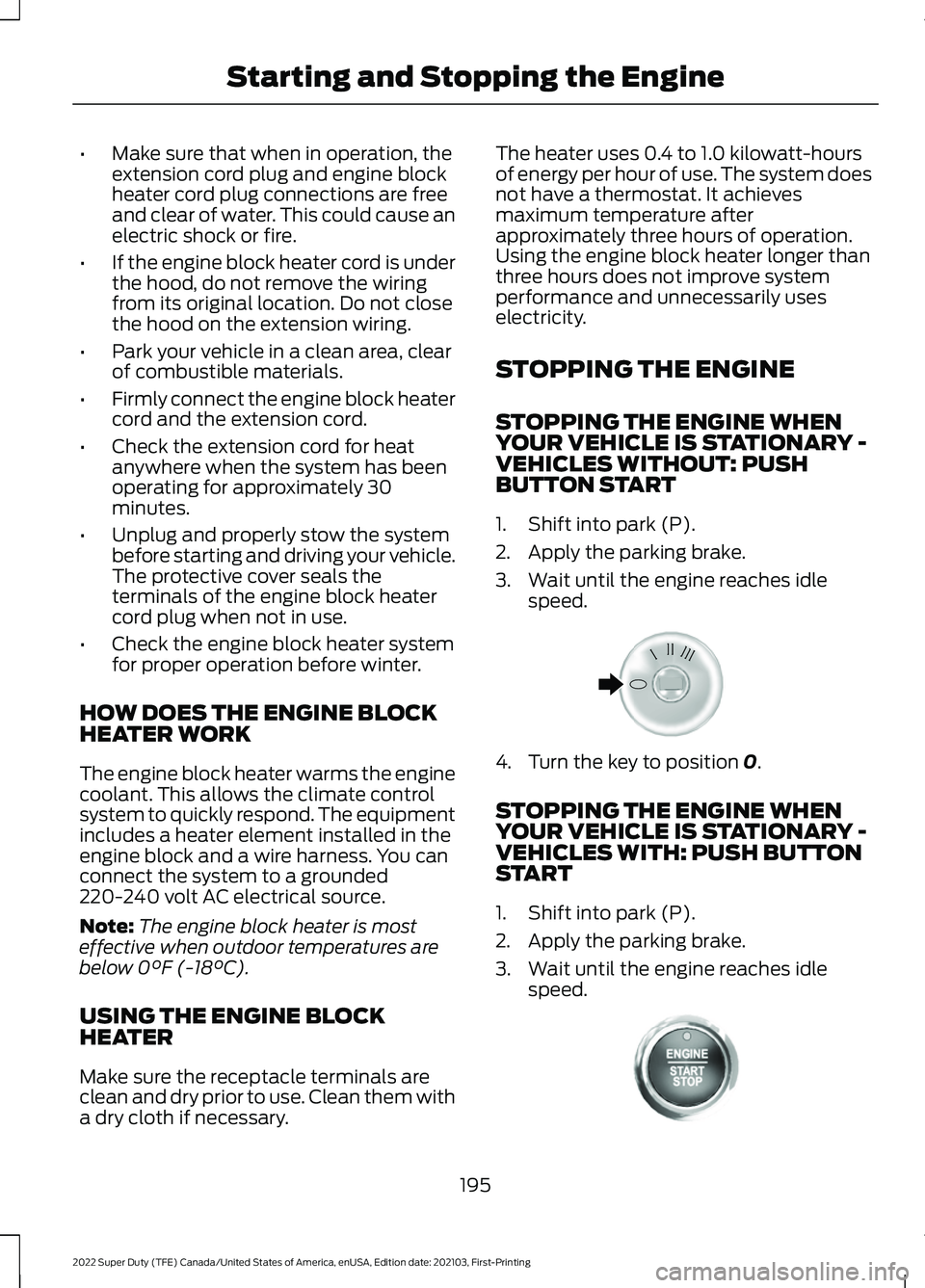
•
Make sure that when in operation, the
extension cord plug and engine block
heater cord plug connections are free
and clear of water. This could cause an
electric shock or fire.
• If the engine block heater cord is under
the hood, do not remove the wiring
from its original location. Do not close
the hood on the extension wiring.
• Park your vehicle in a clean area, clear
of combustible materials.
• Firmly connect the engine block heater
cord and the extension cord.
• Check the extension cord for heat
anywhere when the system has been
operating for approximately 30
minutes.
• Unplug and properly stow the system
before starting and driving your vehicle.
The protective cover seals the
terminals of the engine block heater
cord plug when not in use.
• Check the engine block heater system
for proper operation before winter.
HOW DOES THE ENGINE BLOCK
HEATER WORK
The engine block heater warms the engine
coolant. This allows the climate control
system to quickly respond. The equipment
includes a heater element installed in the
engine block and a wire harness. You can
connect the system to a grounded
220-240 volt AC electrical source.
Note: The engine block heater is most
effective when outdoor temperatures are
below 0°F (-18°C).
USING THE ENGINE BLOCK
HEATER
Make sure the receptacle terminals are
clean and dry prior to use. Clean them with
a dry cloth if necessary. The heater uses 0.4 to 1.0 kilowatt-hours
of energy per hour of use. The system does
not have a thermostat. It achieves
maximum temperature after
approximately three hours of operation.
Using the engine block heater longer than
three hours does not improve system
performance and unnecessarily uses
electricity.
STOPPING THE ENGINE
STOPPING THE ENGINE WHEN
YOUR VEHICLE IS STATIONARY -
VEHICLES WITHOUT: PUSH
BUTTON START
1. Shift into park (P).
2. Apply the parking brake.
3. Wait until the engine reaches idle
speed. 4. Turn the key to position
0.
STOPPING THE ENGINE WHEN
YOUR VEHICLE IS STATIONARY -
VEHICLES WITH: PUSH BUTTON
START
1. Shift into park (P).
2. Apply the parking brake.
3. Wait until the engine reaches idle speed. 195
2022 Super Duty (TFE) Canada/United States of America, enUSA, Edition date: 202103, First-Printing Starting and Stopping the EngineE322405 E321258
Page 209 of 740
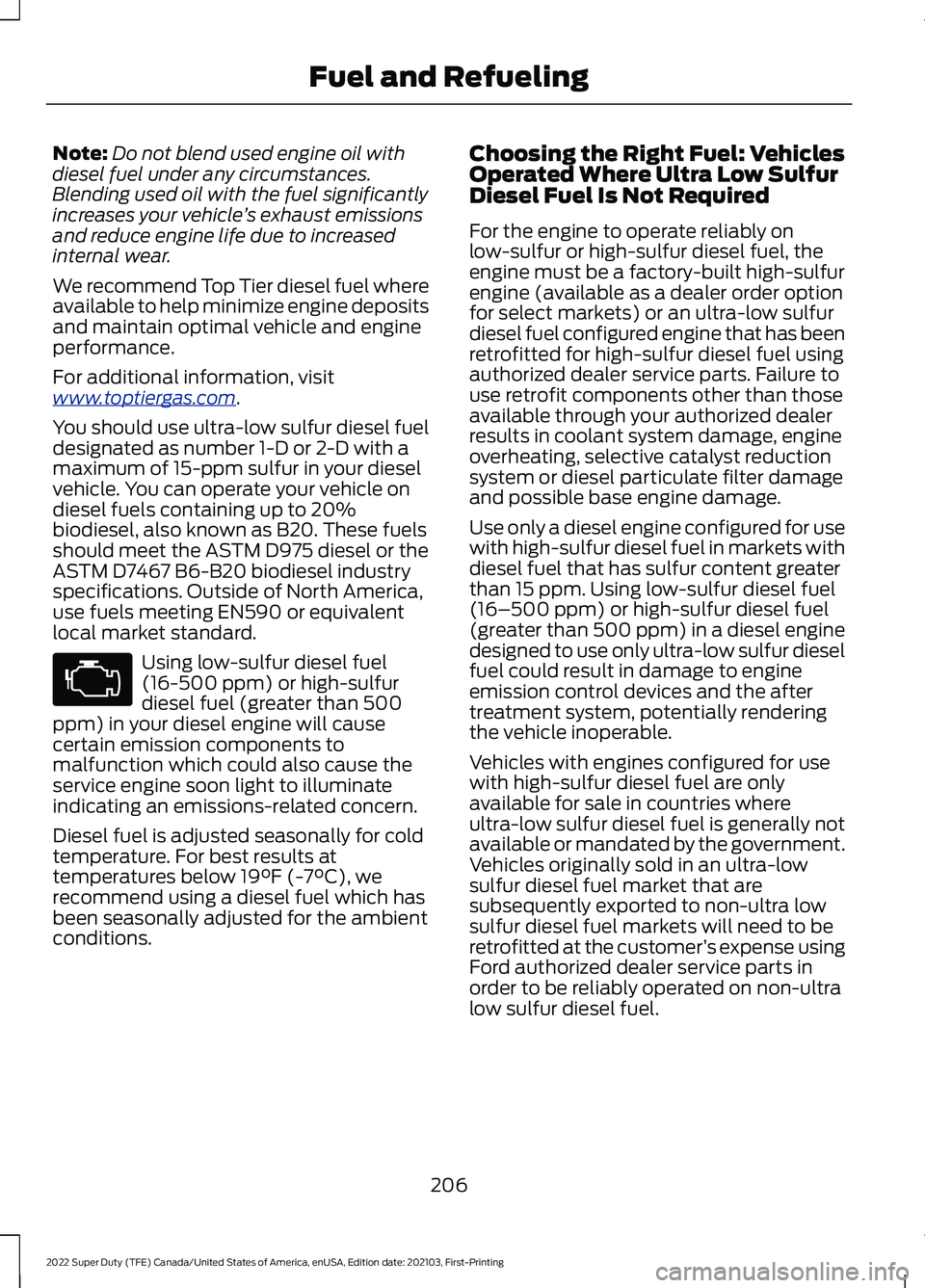
Note:
Do not blend used engine oil with
diesel fuel under any circumstances.
Blending used oil with the fuel significantly
increases your vehicle ’s exhaust emissions
and reduce engine life due to increased
internal wear.
We recommend Top Tier diesel fuel where
available to help minimize engine deposits
and maintain optimal vehicle and engine
performance.
For additional information, visit
www .t op tier g a s. c om .
You should use ultra-low sulfur diesel fuel
designated as number 1-D or 2-D with a
maximum of 15-ppm sulfur in your diesel
vehicle. You can operate your vehicle on
diesel fuels containing up to 20%
biodiesel, also known as B20. These fuels
should meet the ASTM D975 diesel or the
ASTM D7467 B6-B20 biodiesel industry
specifications. Outside of North America,
use fuels meeting EN590 or equivalent
local market standard. Using low-sulfur diesel fuel
(16-500 ppm) or high-sulfur
diesel fuel (greater than 500
ppm) in your diesel engine will cause
certain emission components to
malfunction which could also cause the
service engine soon light to illuminate
indicating an emissions-related concern.
Diesel fuel is adjusted seasonally for cold
temperature. For best results at
temperatures below 19°F (-7°C), we
recommend using a diesel fuel which has
been seasonally adjusted for the ambient
conditions. Choosing the Right Fuel: Vehicles
Operated Where Ultra Low Sulfur
Diesel Fuel Is Not Required
For the engine to operate reliably on
low-sulfur or high-sulfur diesel fuel, the
engine must be a factory-built high-sulfur
engine (available as a dealer order option
for select markets) or an ultra-low sulfur
diesel fuel configured engine that has been
retrofitted for high-sulfur diesel fuel using
authorized dealer service parts. Failure to
use retrofit components other than those
available through your authorized dealer
results in coolant system damage, engine
overheating, selective catalyst reduction
system or diesel particulate filter damage
and possible base engine damage.
Use only a diesel engine configured for use
with high-sulfur diesel fuel in markets with
diesel fuel that has sulfur content greater
than 15 ppm. Using low-sulfur diesel fuel
(16–500 ppm) or high-sulfur diesel fuel
(greater than 500 ppm) in a diesel engine
designed to use only ultra-low sulfur diesel
fuel could result in damage to engine
emission control devices and the after
treatment system, potentially rendering
the vehicle inoperable.
Vehicles with engines configured for use
with high-sulfur diesel fuel are only
available for sale in countries where
ultra-low sulfur diesel fuel is generally not
available or mandated by the government.
Vehicles originally sold in an ultra-low
sulfur diesel fuel market that are
subsequently exported to non-ultra low
sulfur diesel fuel markets will need to be
retrofitted at the customer
’s expense using
Ford authorized dealer service parts in
order to be reliably operated on non-ultra
low sulfur diesel fuel.
206
2022 Super Duty (TFE) Canada/United States of America, enUSA, Edition date: 202103, First-Printing Fuel and Refueling